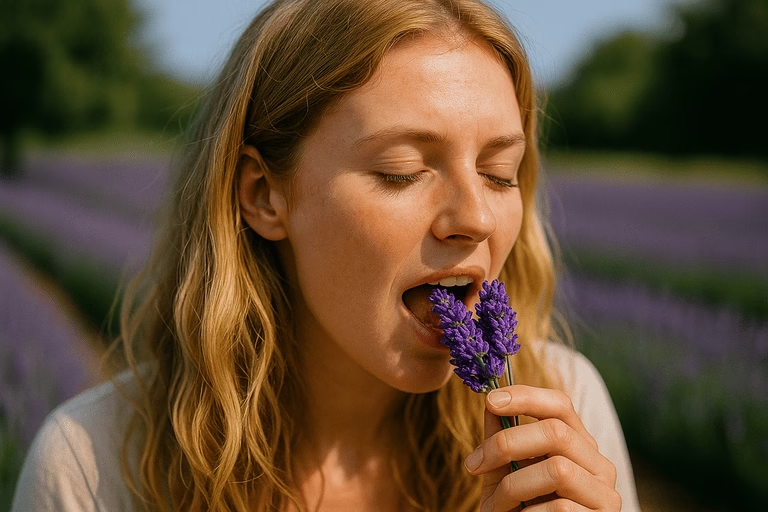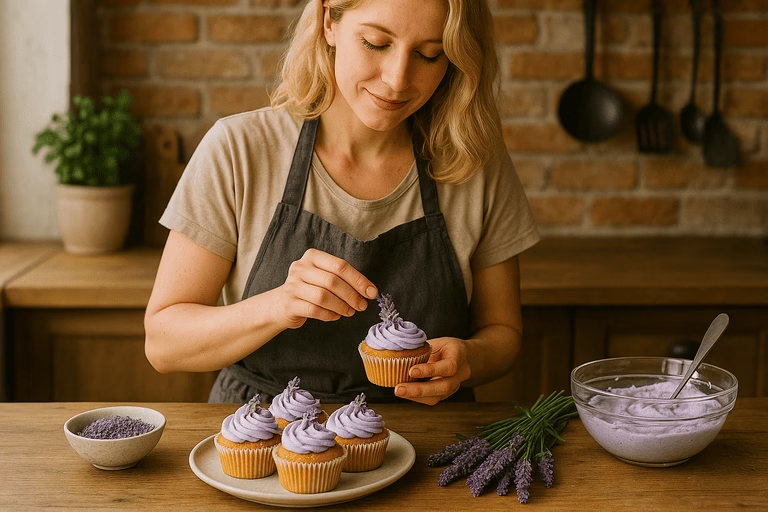Lavender is often admired for its calming scent and elegant purple flowers. However, edible lavender plants go beyond beauty and fragrance—they offer culinary versatility that many people are just beginning to discover. These plants can elevate both sweet and savory dishes, turning ordinary meals into gourmet experiences. If you’re passionate about cooking and gardening, edible lavender plants are an ideal addition to your home.
Benefits of Growing Edible Lavender Plants
There are several compelling reasons to grow edible lavender plants in your garden. First, they require minimal maintenance and can thrive in poor soil conditions, making them perfect for busy or beginner gardeners. In addition, lavender naturally repels pests, reducing the need for chemical pesticides. Beyond practical advantages, the culinary uses are endless. For instance, you can use lavender in herbal teas, cookies, marinades, and even cocktails. Therefore, you get both beauty and function in a single plant.

Top Varieties of Edible Lavender Plants
Not all lavender is safe to eat, so it’s important to choose the right varieties. English lavender (Lavandula angustifolia) is widely considered the best option for culinary use. This type has a sweet fragrance and a subtle flavor that blends well in recipes. Another good choice is Lavandin (Lavandula x intermedia), though it has a slightly stronger camphor scent. In addition, varieties like ‘Munstead’ and ‘Hidcote’ are commonly used by chefs and home cooks alike. Selecting the right edible lavender plants ensures both safety and flavor in your dishes.
Wild Food as a Gateway to Self-Reliance and Natural Living
How to Grow Edible Lavender Plants Successfully
To cultivate healthy edible lavender plants, you need to understand their basic growing requirements. These plants prefer full sun and well-drained soil, ideally with a slightly alkaline pH. When planting, space them about 12–18 inches apart to allow good air circulation. Moreover, avoid overwatering, as lavender roots are prone to rot. Prune your plants regularly to promote fuller growth and more blooms. With these tips in mind, your lavender will not only thrive but also produce flavorful blossoms you can harvest for the kitchen.
Cooking With Edible Lavender Plants: Tips and Ideas
Cooking with edible lavender plants adds a touch of elegance to any recipe. Use the flowers sparingly, as their flavor is quite strong. A little goes a long way, especially in desserts like ice cream, scones, and shortbread cookies. For savory dishes, combine lavender with herbs like rosemary and thyme to season meats and vegetables. In addition, lavender-infused sugar or honey can be a delightful way to enhance beverages and baked goods. Remember to always use organically grown lavender, free from pesticides and chemical fertilizers, to ensure it’s safe to consume.
Health Benefits of Edible Lavender Plants
In addition to their culinary uses, edible lavender plants offer notable health benefits. Lavender contains natural compounds with anti-inflammatory and antioxidant properties, making it a helpful ingredient in herbal medicine. For example, consuming lavender tea can reduce stress and improve sleep quality. Moreover, the plant’s soothing aroma can help alleviate headaches and anxiety. Therefore, adding edible lavender to your meals or drinks isn’t just a treat for your taste buds—it’s also good for your well-being.

How to Harvest and Store Edible Lavender Plants
To get the most out of edible lavender plants, it’s essential to harvest and store them correctly. Begin by cutting the flower stems just before the buds fully open—this is when the flavor and aroma are most potent. Use clean, sharp scissors to avoid damaging the plant. After harvesting, tie the stems into small bundles and hang them upside-down in a dry, dark place for several days. Once fully dried, store the buds in airtight containers away from heat and sunlight. This method preserves their fragrance and taste for months to come.
Nature Tips for Safe and Enjoyable Adventures
Creative Ways to Use Edible Lavender in Everyday Life
Beyond cooking, there are many creative ways to use lavender in your daily routine. You can make lavender syrup to drizzle over pancakes or mix into cocktails. In addition, lavender can be blended into homemade spice rubs, giving meats and roasted vegetables a gourmet twist. Some people even make lavender butter or salt for an extra layer of flavor. Keep in mind that all these ideas work best when using high-quality edible lavender plants grown in your own garden or sourced from reputable suppliers.
Common Mistakes to Avoid With Edible Lavender
While edible lavender can enhance your culinary creations, it’s easy to overdo it. Using too much can result in a bitter or soapy flavor, especially if the wrong variety is used. Another common mistake is harvesting from plants that have been treated with pesticides or fertilizers not intended for food crops. Therefore, always verify the source of your edible lavender plants and use them in moderation. A good rule of thumb is to start small and increase the amount gradually based on taste preferences.
A Brief History of Culinary Lavender Use
Lavender has been used in cooking and medicine for thousands of years. Ancient Egyptians used it during mummification rituals, while Romans enjoyed it in baths, perfumes, and even food. During the Middle Ages, lavender was a key herb in monasteries, often added to preserves and herbal elixirs. In more recent centuries, the French and English have elevated lavender into fine cuisine, especially in baked goods and liqueurs. Today, edible lavender plants are enjoying a renaissance among home cooks and chefs eager to blend tradition with modern tastes.
Bushcraft Fire Starter: Ignite in Any Condition
Comparing Edible and Non-Edible Lavender Varieties
One common point of confusion is which types of lavender are safe to eat. Edible lavender plants—primarily Lavandula angustifolia—have low camphor content and a sweet, mild flavor. In contrast, other species like Lavandula stoechas (Spanish lavender) and ornamental hybrids often contain higher levels of camphor, making them bitter or even mildly toxic if ingested in large quantities. Therefore, always check the species before using it in food. A good rule: if it smells like medicine or cleaning fluid, don’t eat it.

Delicious Recipes Using Edible Lavender Plants
If you’re wondering how to start cooking with lavender, here are a few easy recipes to try:
- Lavender Shortbread Cookies: Add 1 tsp of crushed dried lavender buds to your favorite shortbread dough. Bake as usual.
- Lavender Lemonade: Steep 2 tbsp of dried lavender in hot water with lemon juice and honey, then chill.
- Lavender Chicken Marinade: Mix olive oil, garlic, lemon zest, rosemary, and ½ tsp of ground edible lavender buds for a floral marinade.
These recipes are a perfect way to begin experimenting with edible lavender plants and discovering how versatile they can be in both savory and sweet dishes.
How to Infuse Oils, Honeys, and Vinegars with Lavender
Another excellent way to use lavender in your kitchen is through infusions. To make lavender oil, combine dried buds with a neutral oil (like grapeseed or almond) and let it sit in a warm, dark place for two weeks. For honey, slightly warm a jar of honey, stir in lavender buds, and let it steep for 5–7 days. Lavender vinegar is equally simple: add a few sprigs of fresh edible lavender plants to white wine vinegar and let it infuse for 2–3 weeks. These infusions can be used in dressings, marinades, or even as elegant gifts.
Tips for Pairing Lavender with Other Ingredients
When using edible lavender plants, the key to flavor harmony is pairing them with the right ingredients. Lavender works beautifully with:
- Citrus fruits like lemon and orange
- Berries, especially blueberries and blackberries
- Herbs such as rosemary, thyme, mint, and basil
- Sweeteners like honey, vanilla, and white chocolate
In savory dishes, use it with poultry, lamb, or goat cheese. In desserts, balance it with cream or tart fruits. Avoid combining lavender with bitter or overly earthy ingredients, which can clash with its delicate floral notes.
Quick Recap
To summarize, edible lavender plants are not only beautiful but also practical for culinary and wellness applications. We explored how these fragrant herbs can thrive in your garden with minimal effort and how they add unique flavor to both sweet and savory dishes. We also discussed the most suitable lavender varieties for cooking, their health benefits, and how to properly harvest and store them. Additionally, we reviewed some creative ideas for incorporating lavender into everyday meals and identified common mistakes to avoid.
We went further by diving into the historical use of lavender in cuisine, the differences between edible and ornamental varieties, practical recipes, tips for infusing oils and honeys, and how to pair lavender effectively with other flavors. Whether you’re a seasoned chef or just starting out, edible lavender plants offer an elegant, healthful way to enhance your meals.

